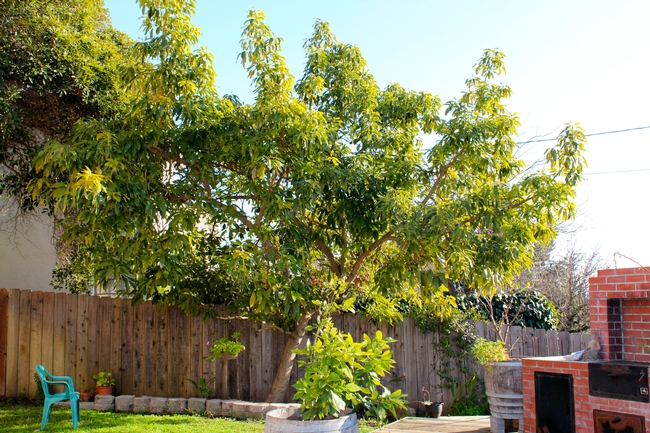Frost Hardy Avocados for Solano Micro Climates
The avocado (Persea Americana) is sometimes described as the perfect food because of its digestibility and nutritional value, according to the California Master Gardener Handbook (2002).
Our backyard has an 30 year old (as yet unidentified) avocado tree which has been a real gem! It produces beautiful fruit and has proven to be frost hardy during a recent mid-January cold snap. Although we live in Vallejo, which is in Sunset’s zone 17 where frosts are relatively rare, Solano County has 3 additional zones: zones, 14, 15, and 9 in the Vacaville area. And you could have your own micro climate within those zones. For example a property on a hill or ridge top will have good “cold air drainage”, with temperatures a good 10-12 degrees F warmer than in lower lying areas.
According to UC Extension San Diego, the ‘Haas’ cultivar is the preferred one for Southern California coastal valley areas, which is where most of them are grown commercially. However, Mexican varieties (Persea americana drymifolia) can be grown in the Bay Area, as well as the “banana belts” of the San Joaquin Valley. Top Sunset Garden Book picks include ‘Fuerte’ (hardy to 27 degrees F), ‘Bacon, ‘Mexicola’ (very cold hardy to 20 degrees F), and ‘Zutano’ (hardy to 27 degrees F). I’m guessing our tree could be a ‘Bacon’, ‘Fuerte’ or ‘Zutano’, because the color of our fruit is dark to medium green, turning darker when ripe. It has a mild, nutlike flavor, and is quite good in a salad.
Fruit ripening varies with the cultivar. ‘Bacon’ and ‘Fuerte’ mature November to March, and ‘Mexicola’ matures August to September. Avocado varieties have flowers categorized as Type A or Type B, depending on the time of day they open and when pollen is released. Sunset recommends either planting a tree of each type, or buying a tree that has the opposite type grafted onto it, which is most likely the case with our tree, since we have only one.
Avocados need good drainage with occasional deep watering. Mulch should be applied 6 to 12” deep, but it needs to be kept away from the trunk. Although these trees are very susceptible to ‘Phytophthora’ root rot, the mulching and additional gypsum added to the soil, creates conditions which suppress this fungus.
So, experiment with this tropical treat. Although your harvest may not be of commercial quality, some of the hardiest varieties can be successfully grown.

Photos by Bud Veliquette

IMG 0847

IMG 0851

IMG 0846
Comments:
Thus far, the star of all my avocados is by far the Zutano. This plant visually looks the most full and healthy and even potted, this particular 4 foot specimen is already producing fruit. At this time I probably about 8 viable avocados developing. It is also this plant that I intend to transplant soon, and hopefully I will be able to make the move stress free as to not cause fruit drop!
@Ken, where can I find a Zutano tree at? i would like to buy one of those kinds as well...
thanks everyone for all the info. we just bought a house and landscaped the entire backyard and im very proud of how it turned out but what is a backyard without planting fruit and veggies and I absolutely love avocado but even though im pretty green at growing anything at all, even I knew that growing avocado might be a challenge here, so thanks for your help..
In regard to the wind issue, I would not be concerned about it where you live in the Green Valley/Suisun area. I have seen them growing in the upper end of Salinas Valley, where the wind is constant at 25-30 mph. Planted together, they protect each other. The main concern is frost protection, and I think it was a smart idea to plant on a high point on your lot for good cold air drainage. Bud
- Todd Charskr


Posted by Karen Norton on February 24, 2013 at 4:59 PM